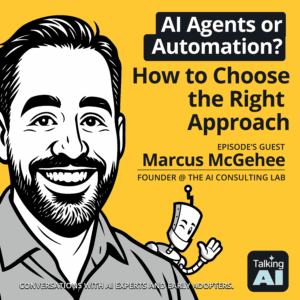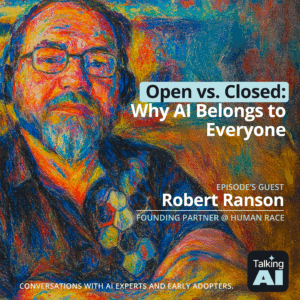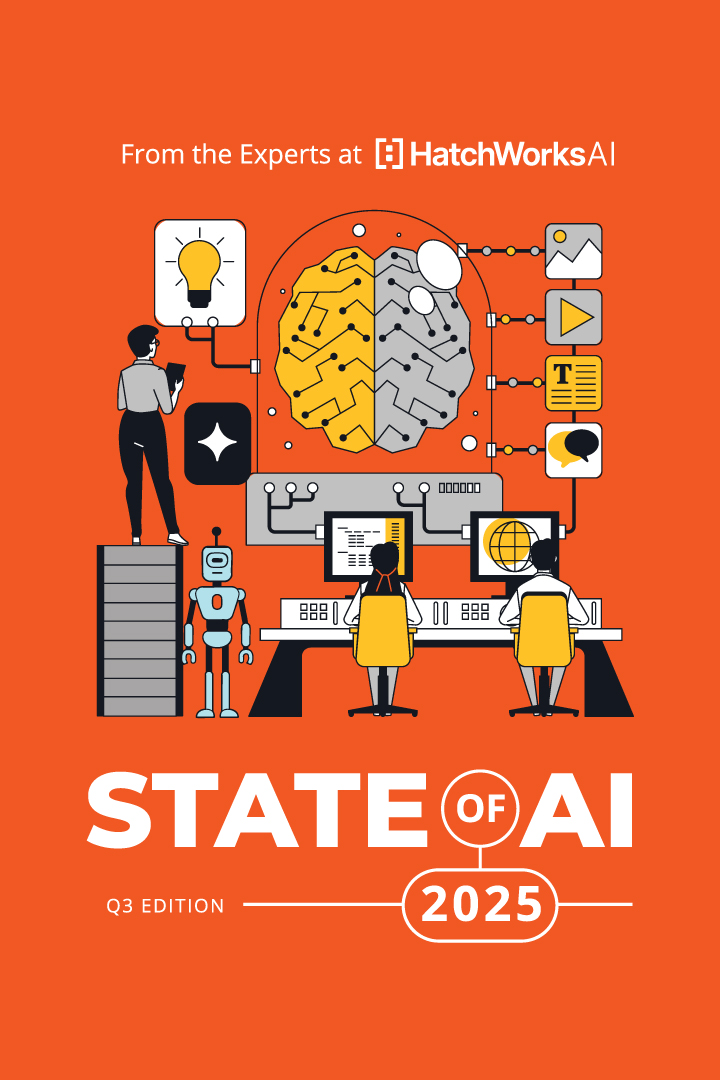If you’re here, you’re probably wondering whether Amazon Q Developer is worth your time—and I get it.
With so many AI coding assistants on the market, it’s hard to tell which ones deliver real value and which ones are just hype.
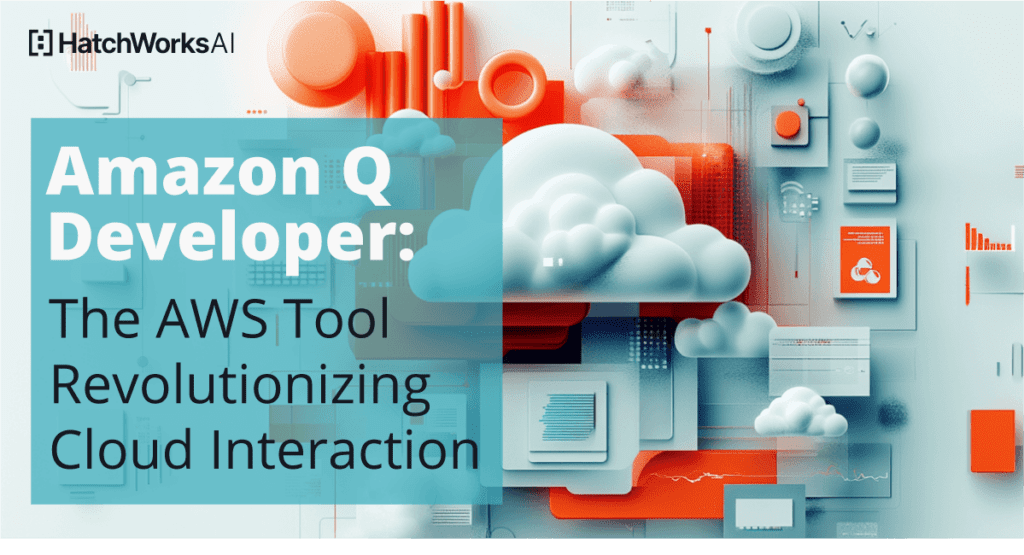
In this article, I’ll break down exactly what Amazon Q Developer is, what makes it stand out, and how it fits into the development process. I’ll also share key insights from my firsthand experience with the tool and how I think it will impact developers working in the Cloud.
👋Hi, I’m David Berrio, Senior ML/AI engineer here at HatchWorks AI. I’m obsessed with all things AI and language models, spending much of my time learning how to leverage them to improve client software projects, our own processes at Hatchworks AI, and my personal hobbies.
What is Amazon Q Developer?
Amazon Q Developer helps developers write, review, and test code faster by leveraging AI.
Think of it like a coding assistant that integrates artificial intelligence directly into tools like Visual Studio Code and IntelliJ IDEA. Through the integrations, the AI is able to suggest code completions, identify bugs, and even generate documentation and tests automatically.
It’s an Amazon product (no surprise, there!) and it uses AWS’s cloud infrastructure and machine learning models.
It’s positioned to compete with other AI-powered developer tools, like GitHub Copilot, by offering more robust support for automated testing, security scanning, and documentation.
Since it’s an Amazon product, it benefits from AWS’s commitment to scalability, security, and enterprise-level support.
Here’s a quick look at its features:
- Code Suggestions and Auto-completion: Provides intelligent code suggestions directly within your IDE to speed up development.
- Automated Code Reviews: Analyzes code for quality issues, suggests improvements, and highlights potential errors or inefficiencies.
- Unit Test Generation: Automatically generates unit tests to improve test coverage and ensure robust application performance.
- Vulnerability Scanning: Scans codebases across multiple languages to detect security vulnerabilities and proposes fixes using AWS CodeGuru’s knowledge base.
- Java Modernization: Simplifies the migration of projects from Java 8 or 11 to Java 17, automating many steps to reduce manual effort.
- Future .NET Migration Support: Plans to support the migration of Windows-based .NET applications to cross-platform .NET.
- Documentation Generation: Creates detailed documentation, such as README files and data flow summaries, directly from your codebase.
- AWS Management Console Integration: Enables natural language interaction with AWS resources, allowing users to perform tasks like listing EC2 instances or checking S3 bucket details.
- AWS-Specific Knowledge Base: Leverages an in-depth understanding of AWS services and configurations for accurate and up-to-date solutions to cloud-related coding challenges.
Feeling Skeptical? I Did Too…At First.
When Amazon Q Developer launched, it stirred up some buzz, but I’ll be honest—I didn’t jump on board immediately. With tools like GitHub Copilot and ChatGPT already dominating conversations, it was hard to see how Amazon Q Developer could stand out.
I’ve tested plenty of these so-called “AI game-changers,” and while some are helpful, many miss the mark when it comes to delivering accurate, real-time support for complex cloud development workflows.
The market is crowded with AI coding assistants, and they all promise the same thing: smarter coding, fewer errors, and faster solutions. But as any developer knows, reality can feel a lot messier.
If you feel similarly about Amazon Q Developer, I understand completely. It was only when I ran into an AWS CDK problem that I learned of the value Amazon Q Developer can bring that other AI can’t.
Finding a Solution in Amazon Q Developer
Months ago, I ran into a problem using AWS CDK (Cloud Development Kit). Addressing it really only should have taken me an hour or so but it dragged on because none of the AI tools I tried had a relevant solution. Suggestions from assistants like ChatGPT or Copilot were either outdated or completely off-base.
So I finally decided to give Amazon Q Developer a try.
I installed the extension in Visual Studio Code, logged in with my AWS Builder ID (a convenient option for anyone testing AWS tools without linking a work account), and gave it a shot.
Within seconds, I had the solution I’d been hunting for. The assistant didn’t just pull in generic answers—it offered a response that was accurate, current, and directly relevant to AWS CDK. That’s when it clicked for me: Amazon Q Developer wasn’t just pulling information from a static, outdated dataset—it was tapping into up-to-date insights that made solving complex issues seamless.
🔗 Related Reading: A Complete Guide to Codestral Mamba – Explore how Codestral Mamba stacks up against other AI coding tools.
Differentiating Between Amazon Q Services
Let me clarify that Amazon Q isn’t a single service. It consists of two distinct tools with different purposes:
- Amazon Q Business: This service is designed for building chatbots that leverage company data from multiple sources to answer questions.
It’s essentially a ready-to-use Retrieval-Augmented Generation (RAG) system, capable of pulling insights from various enterprise systems and data repositories to deliver accurate, contextual answers to business users.
- Amazon Q Developer: This is the focus of this discussion—a tool built specifically to support software development and cloud infrastructure interaction by integrating AI-powered coding assistance directly into IDEs.
Unique Features of Amazon Q Developer
Amazon’s Proprietary Generative AI Model Use
One of the first things I noticed about Amazon Q Developer is its lack of a configuration tab for switching between different Large Language Models (LLMs).
Unlike other AI assistants that let you choose between models, Amazon Q Developer uses Amazon’s proprietary generative AI model exclusively. At first, this felt like a limitation but for cloud engineers, it might be the reason why the tool excels.
When working with AWS-specific tasks, whether configuring EC2 instances or troubleshooting Lambda functions, accuracy matters more than model flexibility.
Amazon Q Developer’s model is fine-tuned with AWS expertise, so it handles cloud-related requests with precision. Rather than pulling vague or outdated suggestions, it offers solutions tailored to the latest AWS updates, making it particularly useful for engineers managing cloud infrastructure.
This proprietary model approach could eventually revolutionize how cloud environments are managed. Instead of navigating complex dashboards or relying solely on command-line interfaces, cloud engineers could perform tasks using natural language commands.
Imagine listing active EC2 instances or adjusting security groups with a simple prompt.
It’s still not at that level but Amazon is setting up the path for this new kind of interaction and UX at the cloud infrastructure level.
AWS Management Console Integration
What sets Amazon Q Developer apart is its integration with the AWS Management Console. Users can interact with AWS resources directly through natural language commands, performing tasks like listing EC2 instances, fetching S3 bucket details, or checking CloudWatch metrics—all from within the IDE.
This integration transforms Amazon Q Developer into more than just a coding tool—it’s a step toward an interactive and efficient approach to cloud infrastructure management.
For cloud engineers, this means fewer back-and-forths between dashboards and more streamlined workflows, all in one place.
Advanced Features Enhancing Software Development
Amazon Q Developer includes tools that make a real impact on modernizing software projects.
Java Modernization
One standout feature is Java Modernization, which allows developers to migrate entire projects from Java 8 or Java 11 to Java 17 with minimal effort.
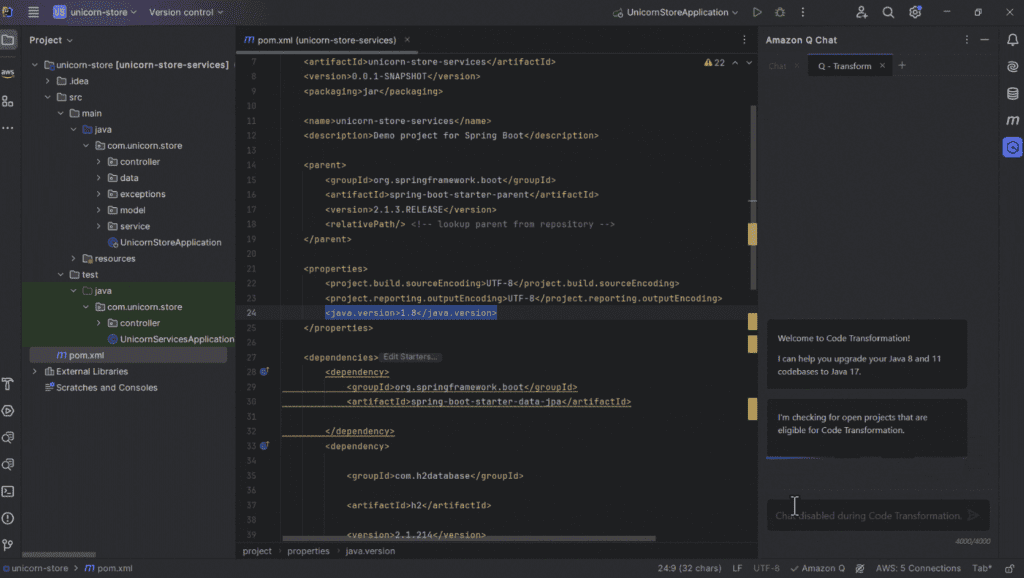
For anyone maintaining legacy code, this can be a huge time-saver. Instead of manually updating APIs, dependencies, and configurations, Amazon Q Developer automates much of the heavy lifting, making the upgrade process smoother and reducing the risk of breaking changes.
For developers focused on keeping applications current and secure, this kind of built-in support is invaluable. Staying on an outdated version of Java can lead to security risks, compatibility issues, and missed performance improvements.
With Amazon Q Developer, modernization of enterprise systems doesn’t feel like a daunting, months-long task—it’s achievable in a fraction of the time.
.NET Applications
Amazon has also announced plans to support the migration of Windows-based .NET applications to cross-platform .NET. This could be extremely useful for developers working to modernize their tech stacks, especially for teams looking to expand beyond Windows-based environments.
Cross-platform .NET adoption opens the door to improved flexibility, scalability, and compatibility across operating systems, which is a big win for organizations aiming to future-proof their applications.
While this feature is still in the works, its potential to simplify .NET modernization could put Amazon Q Developer ahead of other tools in this space.
Vulnerability Scanning for Enhanced Security of Your Business Data
I also want to highlight Amazon Q’s vulnerability scan.
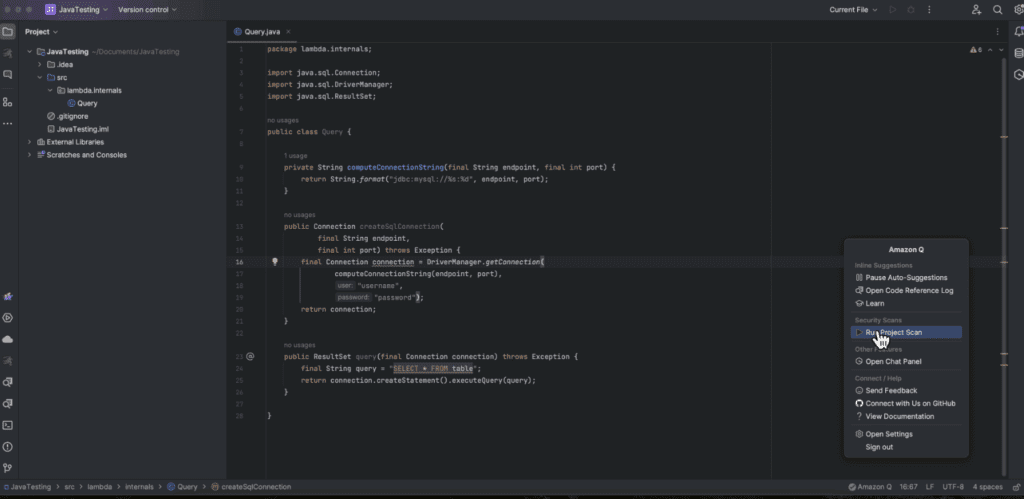
This feature scans entire codebases across multiple programming languages, identifies security issues, and explains each vulnerability in detail. What sets it apart is its use of AWS CodeGuru’s knowledge base, which provides context-specific recommendations and proven fixes based on real-world scenarios.
With this feature embedded in my IDE, I don’t need to switch between tools or dig through external security reports. The fixes are presented in a way that’s easy to understand and apply directly, which means faster issue resolution and fewer blind spots during development.
Time-Saving and Security Benefits of This Feature
From my perspective, security is non-negotiable in development, but traditional security checks can often feel like a bottleneck. Amazon Q Developer changes that by identifying issues early and offering actionable fixes. Instead of sifting through lengthy security reports, I can immediately understand the problem and apply the recommended solution.
By embedding security insights directly into the coding process, this feature not only saves valuable time but also ensures that applications are built with stronger security foundations—something I believe should be at the core of modern development practices.
How Amazon Q Developer is Pushing the Boundaries with its Generative AI Powered Assistant
While Amazon Q Developer does excel at everyday coding tasks, like generating boilerplate code or offering syntax corrections, its real strength lies in its deep understanding of cloud-specific workflows.
For example, it doesn’t just assist with general programming—it supports cloud engineers by simplifying interactions with AWS infrastructure, from configuring Lambda functions to optimizing S3 storage setups.
This specialization positions it as a valuable resource for developers managing complex cloud environments, without losing the flexibility needed for day-to-day development.
Specialization as Amazon Q’s Superpower
General-purpose tools like GitHub Copilot and ChatGPT are great for a wide range of programming needs but can fall short when dealing with niche, cloud-related tasks. Amazon Q Developer stands out by providing more targeted insights and solutions tailored to AWS-based workflows.
This specialization translates into more accurate support for tasks like writing efficient IAM policies or debugging API Gateway configurations.
Features like vulnerability scanning, Java modernization, and the planned .NET migration capabilities add further differentiation, making Amazon Q Developer a tool that covers both infrastructure management and software development in a cohesive, time-saving way.
Service Tiers: Free vs. Pro
Amazon Q Developer offers two service tiers: Free and Pro, with the main differences being the limits imposed on various types of interactions.
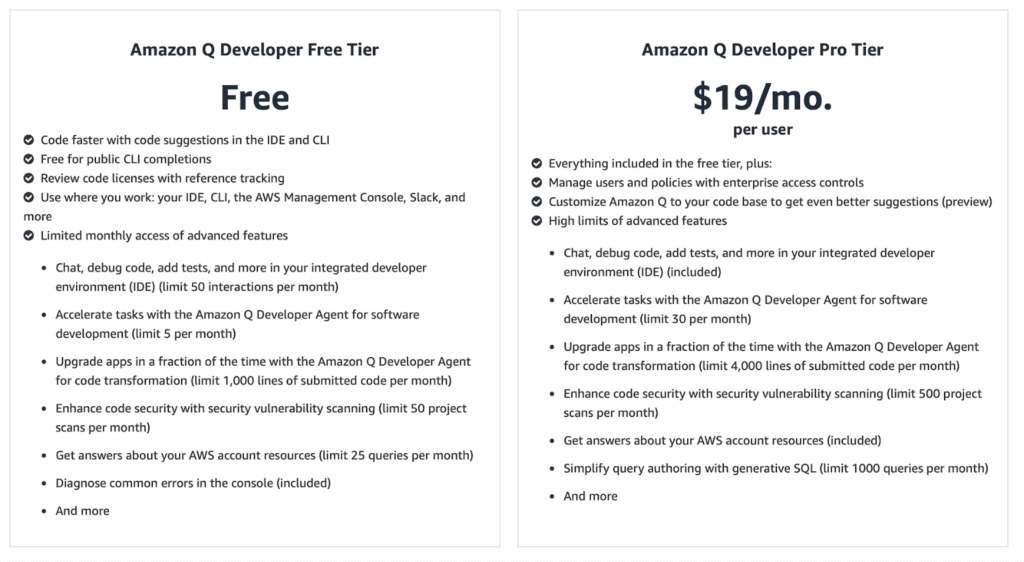
Here’s a breakdown of what each tier provides:
Free Tier:
- Limited number of code suggestions and vulnerability scans per month.
- Basic support for code reviews and documentation generation.
- Suitable for smaller projects or individual developers exploring the tool.
Pro Tier:
- Higher or unlimited usage limits, depending on subscription.
- Full access to advanced features, such as frequent vulnerability scans and Java modernization.
- Prioritized support and integration with enterprise-level AWS services.
Choosing the Right Tier
Deciding between the Free and Pro tier depends on your project needs and how you plan to use the tool.
If you’re working on personal projects, experimenting with AWS, or have minimal security concerns, the Free tier provides enough resources to test its capabilities without cost.
For teams working on large-scale applications or projects with security-critical workloads, the Pro tier is the better choice, offering access to more features and higher interaction limits that ensure smooth development without disruptions.
Ultimately, the Pro tier shines for developers and teams who want to make the most of Amazon Q Developer’s advanced features, particularly when cloud infrastructure and modernization are key parts of the workflow.
Envisioning the Future of Cloud Interaction
I believe tools like Amazon Q Developer represent a new chapter in how we interact with cloud platforms.
Instead of navigating complex dashboards or memorizing endless command-line syntax, software developers everywhere could soon rely on intelligent assistants that bridge the gap between intricate cloud infrastructures and more intuitive, user-friendly interfaces.
This shift has the potential to make cloud computing more approachable, not just for seasoned cloud engineers but for teams of all experience levels. By removing friction from the development process, these assistants could simplify everything from configuring virtual machines to scaling microservices.
The result? Less time spent wrestling with configurations and more time building impactful applications that drive real results.
The Impact of Amazon Q on Developers and Engineers
With fewer hurdles in configuring and managing cloud environments, the focus can return to what really matters to developers: building and shipping high-quality software.
AI assistants like Amazon Q Developer have the potential to democratize cloud computing, making advanced infrastructure accessible to more teams and reducing the steep learning curve often associated with cloud services.
While initial skepticism is understandable, and something I had at the start, Amazon Q Developer’s specialized AWS knowledge and powerful features make it worth trying.
If you’re working extensively within AWS, this tool could completely reshape how you
Adopting AI Is Easy to Get Wrong—Bring in Expert Support with HatchWorks AI
Adopting AI can be complex, and without the right guidance, it’s easy to encounter challenges. That’s where HatchWorks AI can help.
Our team specializes in using artificial intelligence and guiding organizations through cloud transformations, ensuring they maximize the benefits of AI-powered tools to enhance productivity and streamline operations.
We also offer:
- AI-Enabled Digital Products: Developing custom AI solutions that enhance user experience, drive revenue, and optimize development lifecycles.
- Generative AI Innovation Workshops: Equipping your team with the knowledge to understand and apply Generative AI to real-world business use cases.
- Retrieval-Augmented Generation (RAG) Accelerator: Integrating your proprietary data with AI to provide real-time, accurate insights without expensive model training.
With a proven track record and recognition as the #1 AI Services Company in the US by Clutch, HatchWorks AI is your trusted partner in navigating the complexities of AI adoption.
Get in touch to schedule a consultation and discover how we can support your team in adopting the right tools for success.
FAQs About Amazon Q Developer
What is Amazon Q Developer?
Amazon Q Developer is a generative AI-powered assistant designed to enhance software development, particularly for AWS-related workflows. It provides features like code suggestions, vulnerability scanning, and infrastructure interaction to improve productivity and accuracy.
How does it differ from Amazon Q Business?
Amazon Q Developer focuses on code assistance, cloud interaction, and software modernization.
Amazon Q Business, on the other hand, specializes in building chatbots that leverage enterprise data repositories to answer questions, functioning as a Retrieval-Augmented Generation (RAG) system for all business data and queries.
Can it help with legacy code modernization?
Yes, Amazon Q Developer offers new features like Java modernization, enabling seamless migration from Java 8 or 11 to Java 17. Additionally, it has announced plans to support the migration of Windows-based .NET applications to cross-platform .NET, making it a powerful tool for modernizing legacy applications.
Which programming languages are supported by the vulnerability scanning feature?
Amazon Q Developer’s security scanning capabilities support multiple programming languages—commonly Java, Python, and JavaScript. This generative AI powered assistant uses advanced generative AI technology integrated with AWS resources, helping software developers efficiently handle code transformation tasks and performing security scanning. By leveraging artificial intelligence, it provides detailed insights to help IT teams securely complete tasks and mitigate risks during the software development process.
Does Amazon Q Developer store or analyze my code on Amazon’s servers?
Yes. To generate content and conduct performing security scanning, Amazon Q temporarily processes your code using underlying models within AWS infrastructure. However, Amazon enforces strict data protocols to ensure your code is protected. This generative artificial intelligence approach is designed so you can securely complete tasks on enterprise systems without compromising sensitive data or impacting compliance requirements.
How does Amazon Q Developer compare to GitHub Copilot or ChatGPT?
While GitHub Copilot and ChatGPT are versatile generative AI tools, Amazon Q stands out for its focus on optimizing AWS resources and streamline tasks specifically in AWS environments. Its generative ai powered design addresses developer requests like security scanning, code transformation, and AWS console interactions. This specialization means software developers can see real productivity gains by tapping into AWS-native features—something more generalized tools may not provide as effectively.
Is Amazon Q Developer suitable for beginners, or is it only for advanced developers?
Amazon Q is built to assist a wide spectrum of software developers and IT professionals. Beginners can rely on its conversational interface for straightforward guidance and repetitive tasks, while experienced teams benefit from accelerating software development through automated complex calculations and advanced generative ai technology. Whether you’re new to AWS or modernizing enterprise systems, the tool’s intuitive design helps securely complete tasks and realize immediate productivity gains.
We’re ready to support your project!
Instantly access the power of AI with our AI Engineering Teams.
